23 September 2022
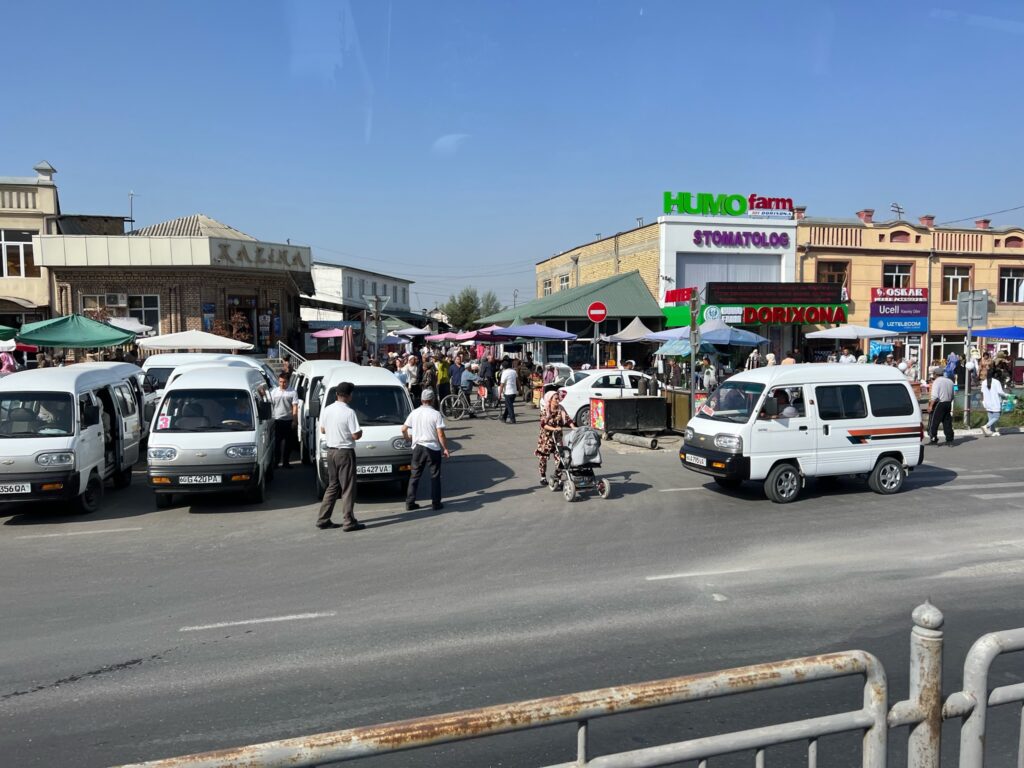
What a difference a border makes. Although it looks chaotic, was a bit slow and bureaucratic, and the temperatures were heating up, it was clear we had entered into a new country and a new culture. Immediately one begins to see the Persian influence in faces and architecture.
There were few smiles getting stamped out of Kyrgyzstan. However, the “Welcome to Uzbekistan” and smile from Uzbek immigration was refreshing. He asked a few questions, like was I from the United States and do I speak English. Strange considering he was looking at my American passport, but welcoming all the same. Quite a contrast to what we’ve seen in Kazakhstan and Kyrgyzstan.
It was a gauntlet of fruit and produce sellers outside customs. Cars were aimed and determined, honking and inching out of parking spots. It was a lively welcome to Uzbekistan. Lots of migrant Uzbek workers come to cross the border into Kyrgyzstan to be hired for day labor. Huge, heavy carts of produce, even a washing machine, were making their way to join the cacophony of sellers just beyond customs. We walked to our bus and were whisked away in air-conditioned luxury. We enter a new time zone but it remains hot and dusty so no welcome change there.
It is easy to see that Uzbekistan is more commercially developed and prosperous. It is not just agriculture and cows. It seems most of the road is lined with businesses, shops, and services. What fields I see are rich with cotton, grapes, corn or orchards. The occasional cow is in a field but nowhere do I see a herder or horse cart. Haven’t noticed an abundance of rocks but do see fields of cotton being picked by hand.
Our first stop is Margilan which our guide says was founded by Alexander the Great. Evidently, on a lunch stop, Alex was fed chicken called murgh in Persian, and bread, nan in Persian. By the end of lunch, Margilan had its name. More accurate history indicates that Margilan was an important stop on the Silk Road as early as the 9th century AD.
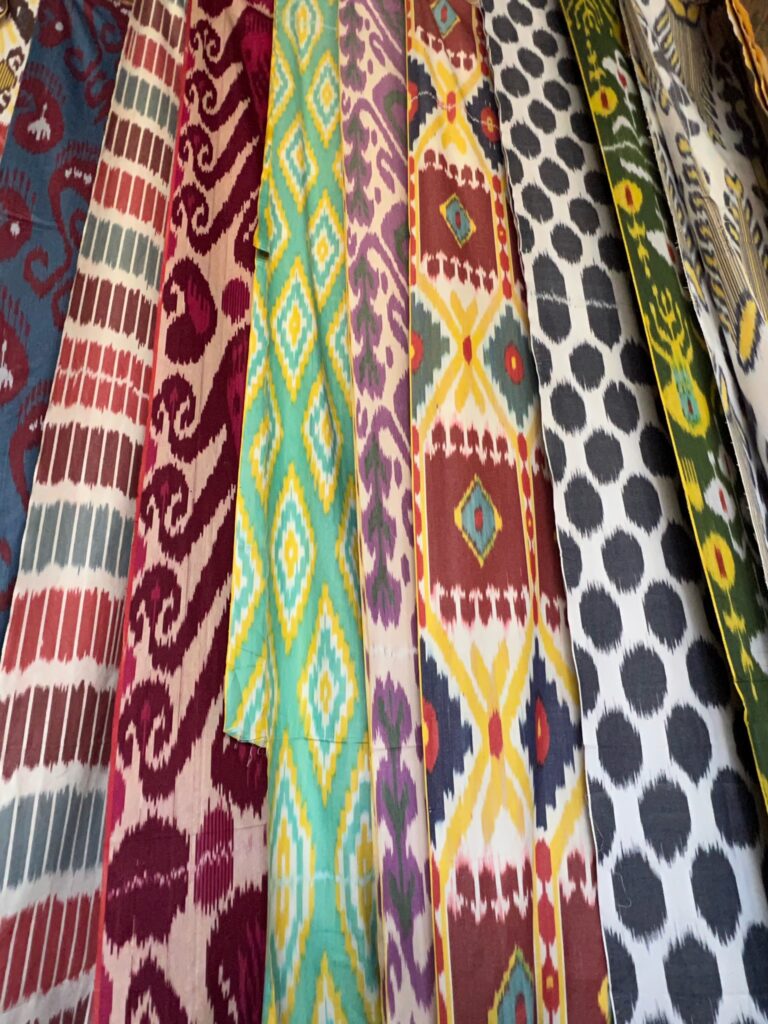
We stop in Margilan to visit the Yodgorlik Silk Producing factory that practices the ancient traditions of weaving silk by hand. Established in 1983 in an attempt to preserve traditional silk weaving techniques, the large factory produces its own silk and beautiful handmade items. It employs over 200 workers and the full production process takes place in the factory, from the feeding of the silk worms with their own mulberry leaves, to dyeing the silks with natural mineral and vegetable dyes, to weaving the silk. We toured the plant. We also had an opportunity to see how they dyed silk scarves. What looked to be a messy process produced a beautiful, naturally dyed silk scarf.
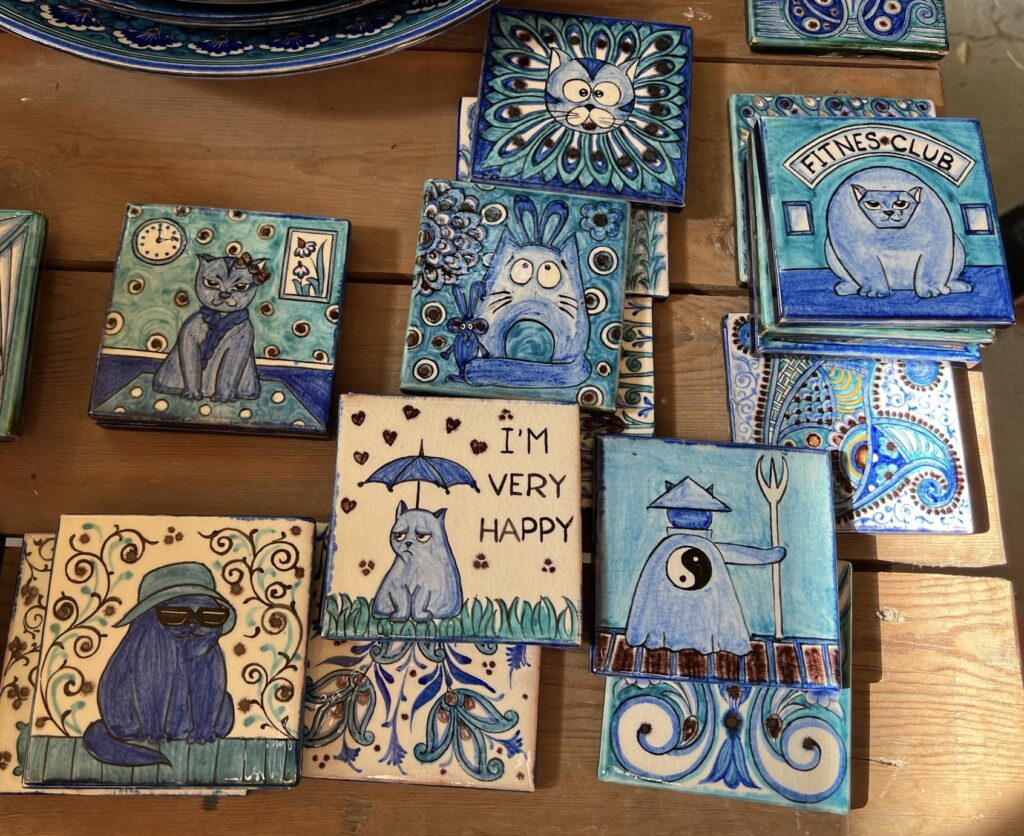
After Margilan, we continued about an hour to the small town of Rishtan, known for its blue ceramics. We visited the home and business of Rustam Usmanov who is a master pottery maker. After watching the making of clay pottery, we observed its delicate painting. The plates, cups and bowls are beautiful. But, I have more than enough stuff.
We drive the rest of the way onto Kokand where we will stay the night. It is hot and dusty, temperature reaches 90°. This is a country of predominantly white cars as they are cooler. You will rarely see another color, an occasional yellow, once in a while gray or beige, rarely an insane black. We reach town in our white bus.
Kokand is a thriving commercial community. Business, cafes, shops and restaurants abound. I notice we stop for pedestrians but only as long as they are in front of the bus. I wonder how many are run over for not being quick enough?
We visit the 19th century Palace of Khudáyár Khán. It has a bare hint of its original grandeur thanks to Russian destruction. Known as the Pearl of Kokand, the palace was constructed in the tradition of Central Asian architecture with strong Persian influences, especially the high central portal opening into the large courtyard. Four minarets remain: two of them either side of the portal, and two at ends of the facade – each pair are differing shapes.
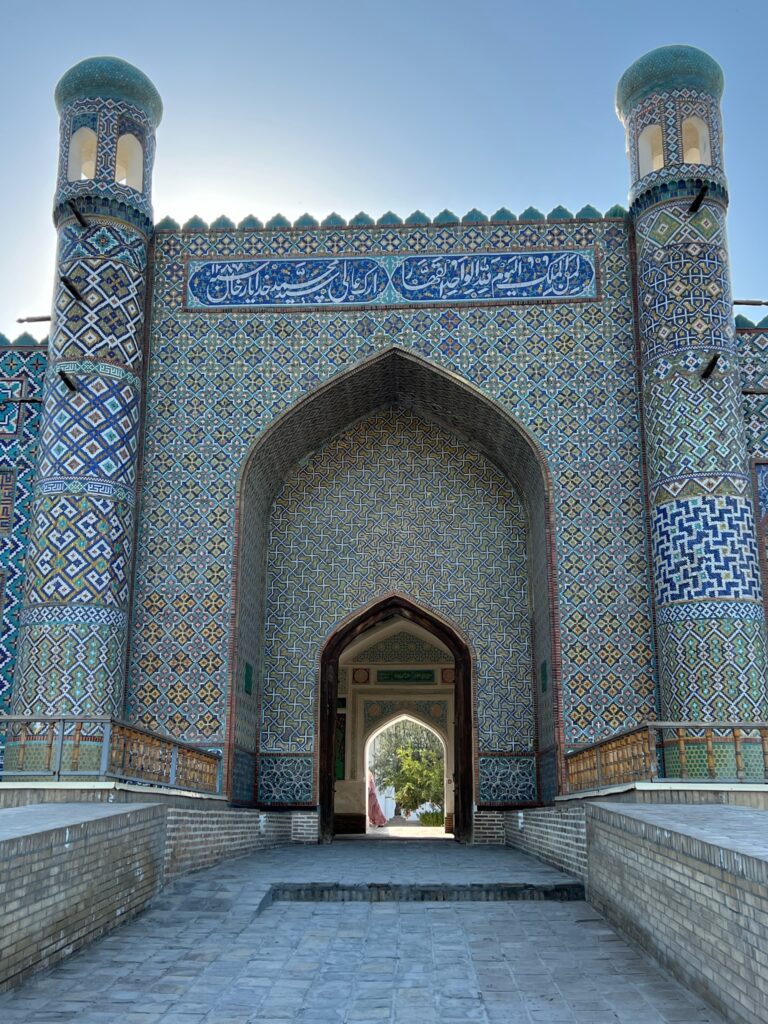
The palace is surrounded by a carved stone wall and once consisted of seven small courtyards and 119 very ornate rooms over an area of 4 acres. Above the main entrance is inscribed the Arabic inscription: “Great Seyed Mohammad Khudoyar Khan.” Over 16,000 people and 80 masters worked on its construction. The biggest drawback was that most of the workers had little choice but to do the Khan’s bidding. “No, I’m busy” was not an option.
However, their efforts are appreciated as the palace is beautiful. The colorful ceramic tiled facade, minarets, rich ornamentation, geometric designs, arabesques, and floral motifs are stunning. Unfortunately, only two of the courtyards and 19 rooms survived the Russian onslaught. However, walking through the high arching entrance, visiting the interior rooms and their grand ceilings, I know the Khan and his harem lived well.
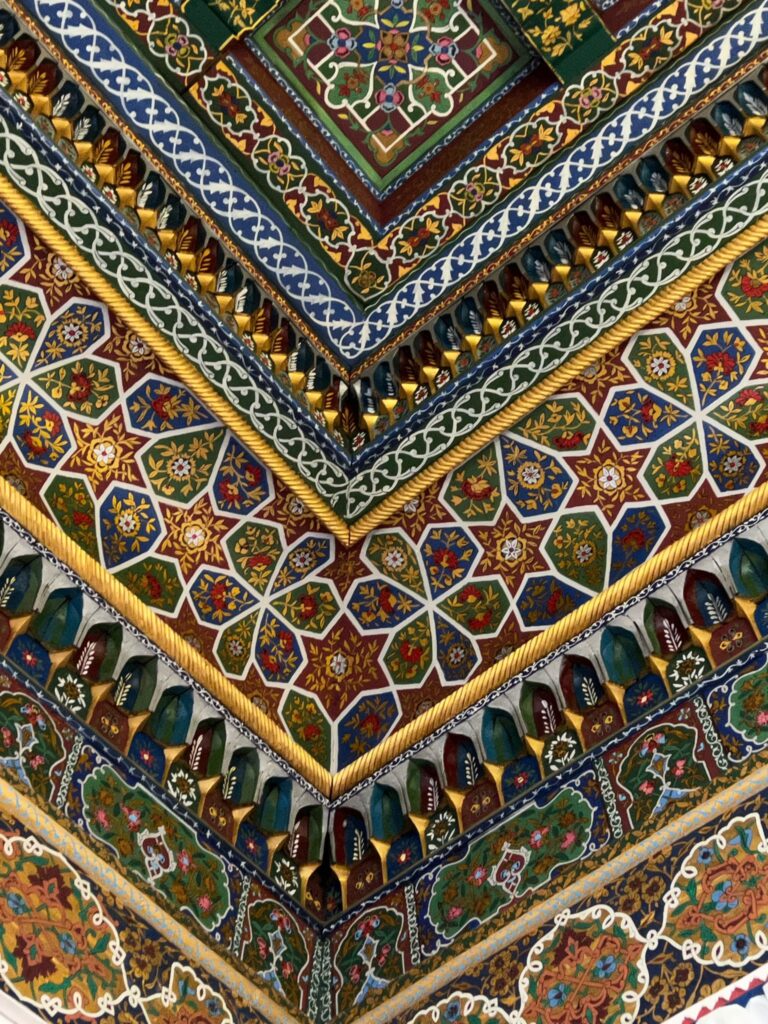
In the 18th-19th centuries, Kokand was the center of a large and important khanate and many mosques were erected, numbering over 230 neighborhood and 18 Friday mosques. Friday Mosques are very large and important mosques used for worship on Fridays; we visit one of the most important ones.
As early as the 9th century, there were mentions of the Juma Mosque which stood in Chorsu Square in Kokand. During the Mongol invasions the Juma Mosque, as well as the entire city, was destroyed. However, in 1805, Kokand Olimhan started to build a new mosque. Construction was stopped after the superior of the mosque opposed the cost of the mosque being collected by force from the common people.
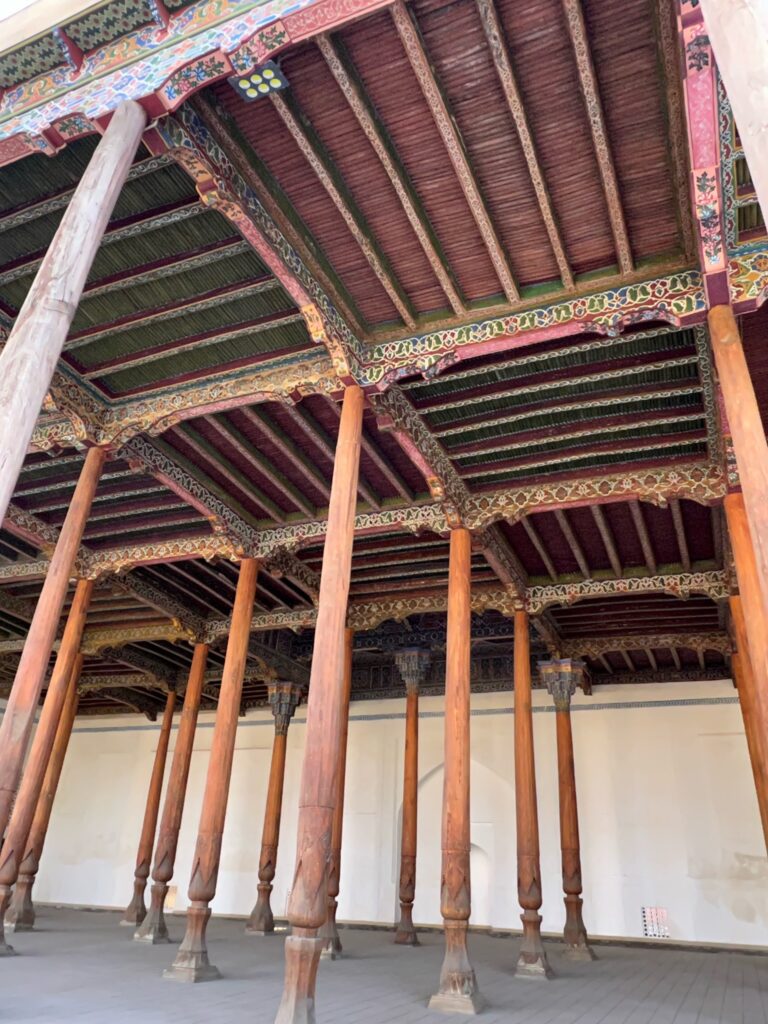
In 1814, Umarkhan, a more enlightened and humane ruler of the Kokand Khanate, restarted the construction of Juma Mosque. A master architect was used and over 200 builders worked under his supervision. The mosque was shut during Soviet times and reopened after restoration in 1989. The entire complex is now a museum. A Madrassah is also part of the large complex.
In the center of the courtyard is a 72’ minaret from which the muezzin call the faithful to prayer. According to legend, criminals and disloyal wives were thrown down from this minaret. Our guide says not so.
But the most spectacular part of the complex is the colorful, artfully carved 330 foot-long open portico supported by 98 wood columns brought from India and each uniquely carved by masters. The high decorative ceiling remains vibrant. The mosque is still used every Friday for prayer.
There still is a huge imbalance between the sexes. Told the area served 10,000 in prayer, it is clearly for men. “It is better for women to pray at home.” The madrassa is often for boys only. A few are being converted for girls where they now may study embroidery and other sewing skills.
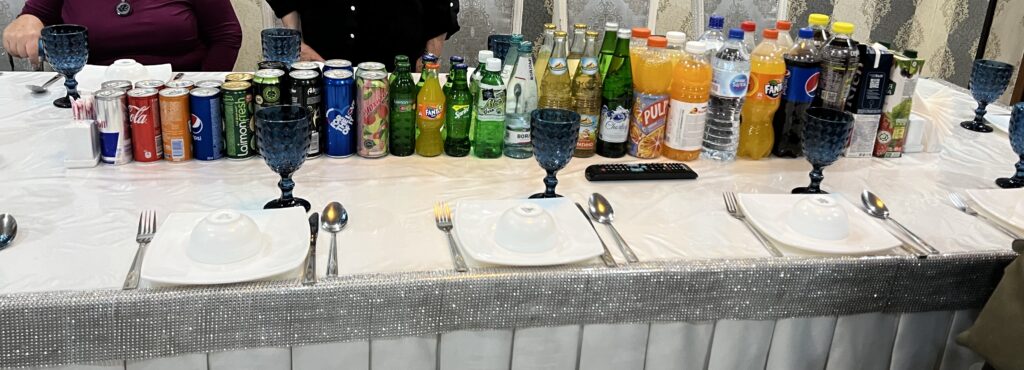
It has been a hot day. Temperatures are around 90° and the air is very dry with humidity in the teens. Uzbekistan is also pretty dry when it comes to alcohol. So it is back to the hotel in our culturally appropriate white van before driving our white van to dinner. There is an incredible assortment of drinks in the middle of the table, but not one drop of alcohol. I figure I still have it a whole lot better than the khan’s wives, or most of the women I see. No complaints.
0 Comments